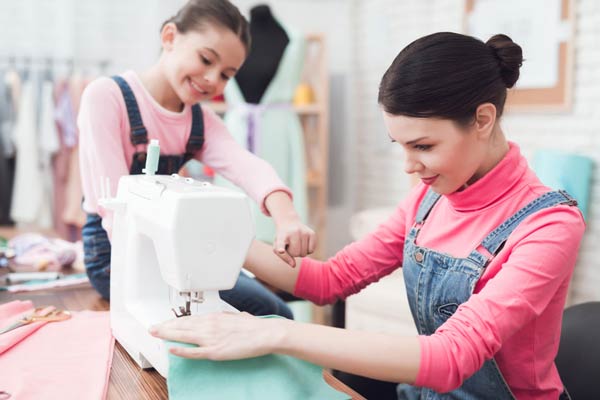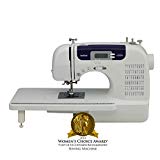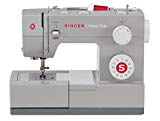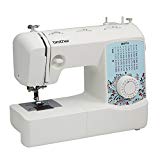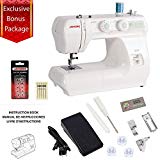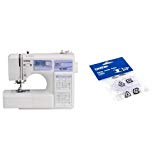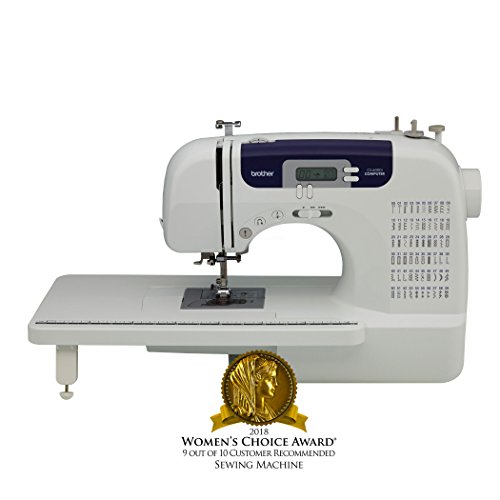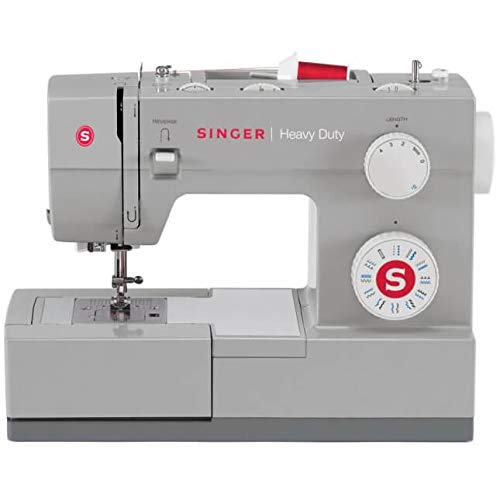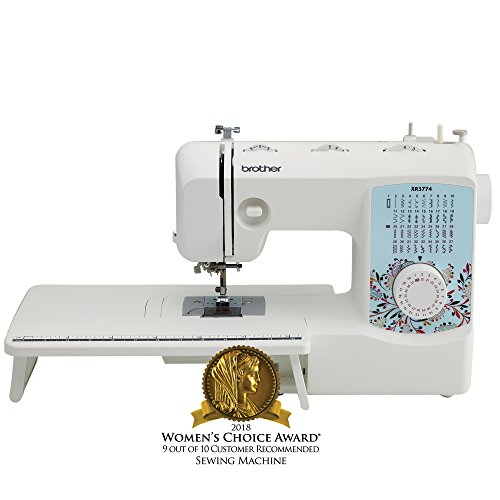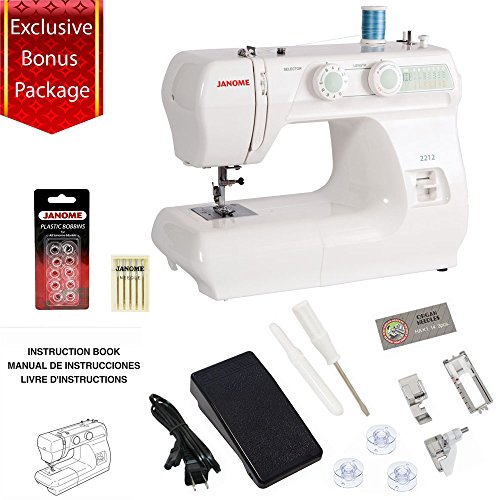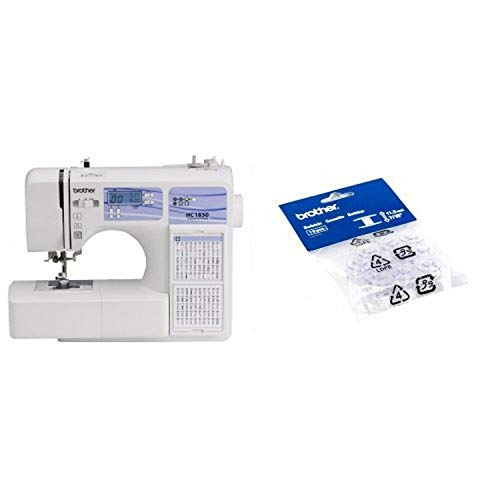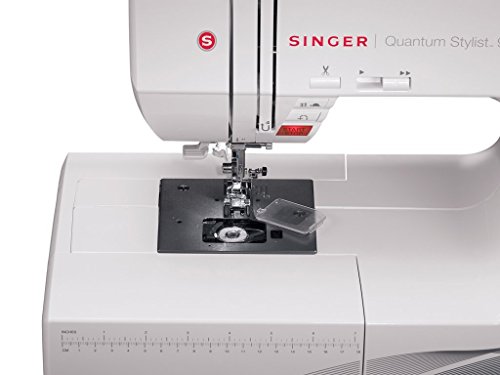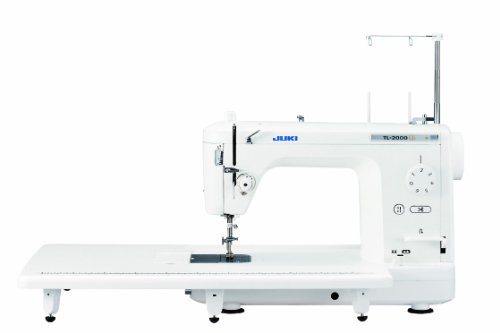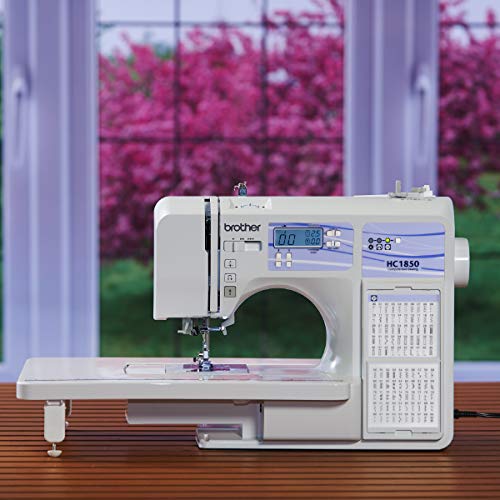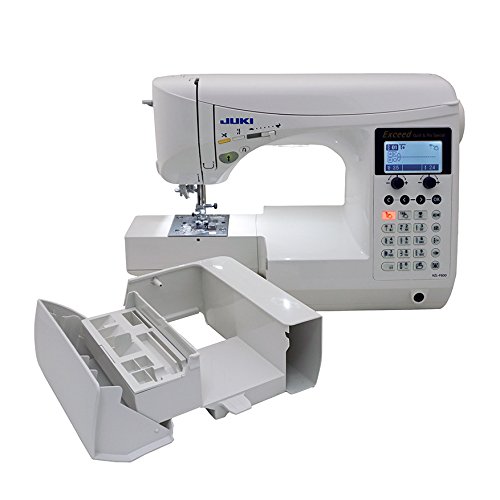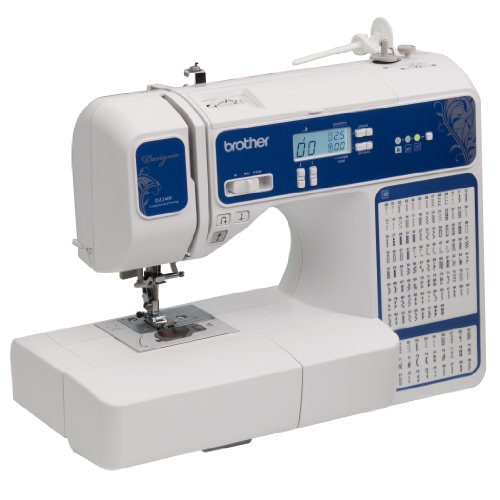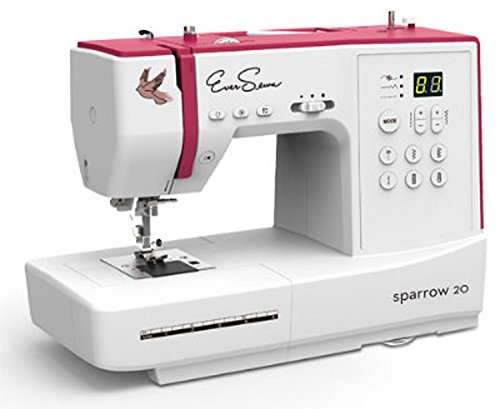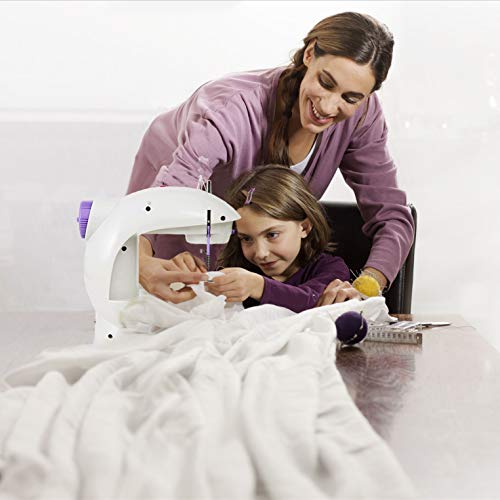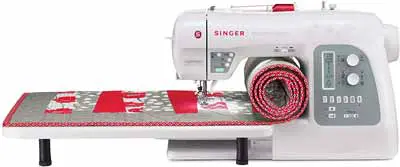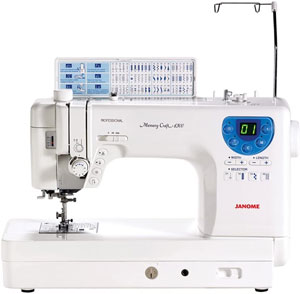Best Sewing Machine For Quilting 2023 : Reviews By An Expert
Have you ever quilted with a regular sewing machine?
If the answer is yes, then I think you’ll agree when I say,
“Quilting with a regular sewing machine is extremely difficult”
There isn’t enough space for quilt works, the fabric clusters up and increases the tension that is hard to regulate.
It can take 2-3 times more than a simple stitch work usually needs. Frustrating, isn’t it?
Yet, you can’t just stop quilting. I mean, it’s fun, addicting and greatly satisfying.
So, what to do? If you’re serious about quilting, the old sewing machine won’t cut it anymore. You need something that’s specifically made for quilting and patchwork. The right equipment can help you make more beautiful designs with lesser efforts.
Here’s where the best sewing machines for quilting come into play.
If you’re thinking ‘oh I’ll just get a singer because I’ve always had it’, we’d suggest you hold your horses. You’re going to use it day and night (that’s what addicts do, right?), so it’s important that your quilting machine “feels” right.
Each machine has different features, sounds, even stitches. Also, a lot has changed for sewing machines in the last couple of years. So we suggest you take time, get to know different machines that are presiding the market and choose your ultimate one.
We’ll be more than happy to help you with the process. Fasten your belts because we’re going on a journey to the fairyland of quilting. We’ll discuss everything you need to know about quilting machines, how they work, how to maintain them and the best products for quilters. Grab a cup of coffee and read along.
Need a quick decision? Here's my Top 5 Best Quilting Sewing Machine picks:
Image | Name | Editor's Rating | Price |
|---|---|---|---|
5 out of 5 | |||
5 out of 5 | |||
4.5 out of 5 | |||
5 out of 5 | |||
4 out of 5 |
Table of Contents
What Is Quilting?
Simply put, quilting is the process of joining several layers of clothes, usually 3 or more, so that the final product is a denser and warmer cloth. Out of 3 layers, the above one is the top layer where you sew various designs. The middle layer is called wadding, which acts as padding. The final layer is called backing, which is used to keep the wadding in place.
You can quilt by hand or machine. Although the latter is easier, time-saving and less exhausting. You can use one of several stitches to quilt. However, the basic running stitch is the most common and easiest one.
There is a difference between normal sewing and quilting. While sewing is the process of joining fabrics together, quilting refers to joining them in a sandwich-like manner. You can say, not all sewing is quilting, but all quilting is sewing.
What Is Quilting Sewing Machine?
As you can presume from the name, a quilting machine is a specialized sewing machine that quilts. Obviously, any sewing device can quilt to an extent, but it’ll take time and lots of effort. A sewing quilting machine has some characteristics that make it suitable for the job.
1. Workspace: For regular sewing works, having ample space to sew or manage fabrics is a luxury, but not necessarily need. But for projects where you have to handle bulky fabrics and sew them together, space is a prerequisite.
Long arm quilting machines come with that space. The area is determined by the length of the machine. Larger machines have a larger throat, which provides the user with a degree of freedom.
2. Extension Table: Quilt sewing machines usually come with extension table, just in case you need more space. The table fits against your machine and gives you extra space for sewing on borders and bindings.
3. Customized Threading Options: Quilting machines come with various stitching and threading options. Which, if done by hands, would have taken a lot of time. You get embroidery options, font options, and numerous seam combinations.
4. Easy To Work With: It might take days, even months to complete a quilt work by hand stitching. On top of that, if you need to change your stitch instantly, it becomes difficult.
Not with quilting machines. They allow you to change your stitch instantly and mid-stream. Also, there is a lot of custom options that’ll allow you to reach the design you aimed for.
5. Thread Tension: That’s one of the key disadvantages of stitching with hands. If you’re going to stitch several layers at a time, probably 3 or 4, it’s really tough to maintain strong thread tension.
As a result, the layers will move over each other and feel wobbly. Sewing machines for quilters maintain strong thread tension without burning the motor or breaking the needle in the process.
What Are The Benefits Of Using A Quilting Machine?
Now, having a quilting machine present you with a load of benefits. You can make fully custom quilts within a short time. And if you’re a fan of custom hand stitching, you can still do some freehand stitching after the major works are done.
Below, we are going to discuss the benefits of using a quilting machine.
1. Convenience
If you own a regular sewing machine and trying to quilt with that, you know that’s not completely possible. Often, you’ll have to go to someone who possesses a quilting machine and get the complex designs done.
With a machine at your disposal, you’ll be able to make customized designs in your home. You can quilt whenever you want. You will be able to create beautiful designs that are also truly homemade.
2. Beginner Friendly
Sewing by hands is an extremely delicate craft and needs months, even years to master. The process might seem tiring for a complete noob. With a machine, you can omit the manual labor and focus on the creative side of yours.
Usually, sewing machine for beginner quilters come with a detailed manual and numerous stitching options. You can learn the process within days. Using scrap clothes and the creative mind of yours, you’ll be able to do awe-inspiring designs.
3. Adjusting Stitching Width
A high-quality machine will allow you to adjust the width of the stitches and the space between them. You’ll usually get a width option up to 5 mm and some machines will allow you up to 7mm space between stitches.
This will allow you to do a wide range of designs. Also, the stitches will be tight and secure.
4. Saving Money
Having such a machine allows you to make use of scrap and old clothes and turn them into something useful. Also, the machine allows you to fix torn clothes, resolve the sewing flaws and even adjust the size of an outgrown cloth.
5. Earning Potential
Yes, it’s a real possibility. Not everyone possesses a quilting machine, and they might need the use of it from time to time. And you can make money from resembling the current trendy designs with your sewn work.
Also, a quilting machine allows you to craft something out of the box. And if the customers like it, you can work on batch production using the machine. You know, making money by speeding up the process.
Our 16 Best Sewing Machine for Quilting Reviews 2020
1. Brother CS6000i Sewing and Quilting Machine
Even legends had to start somewhere, right?
Unless you completing that learning curve, there’s no walking to the hall of fame. And for that, there’s probably no machine that is better than Brother CS6000i.
It has everything a beginner can dream of. It is computerized, well-built and easy to use. With 27 built-in stitches, which can be selected by stitch selector, you’ll never run out of options. Sewing back and forth, zigzag, overcast stitches, you name it, and the machine will gladly provide you.
On top of these, additional features like adjustable sewing speed and automatic needle threader will help novices build their experience. It has a top speed of 850 stitches per minutes, but you can adjust it. Also, the top drop-in bobbin system allows you to get started within moments.
The machine weighs 13 pounds and 16 x 6.7 x 11.4 inches in dimension. You shouldn’t face any problem carrying it around. The throat space by itself will provide you ample space to regulate fabrics. However, you’ll get more space if needed thanks to 2 outstanding features, free arm, and wide table.
Worried about difficulty seeing stitches on dark clothes? The manufacturers had it covered too. The brightly lit sewing area will help you see how your needlework going.
This is the best quilting sewing machine for beginners, and that’s not an overstatement. I mean, this beast here comes with 8 sewing and quilting feet! One of them is a walking foot, which facilitates you to feel multiple layers through the fabrics. The guide and quilting foot help you keep the stitches evenly spaced.
All of these come with a hard protective case and a compact, nicely packed box. You’ll have everything to get started at once. You can do a lot of tasks including stitching sleeves, adding buttonhole, and sewing zippers. If you were looking for a gift idea for your loved ones, this one has got you covered.
Highlighted Features:
2. SINGER | Heavy Duty 4423 Sewing Machine
I think you’ll agree when I say, look does matter when it comes to machines.
If you’re seeing a manufacturer claiming a thin, cheap looking machine do wonders, it probably isn’t.
However, that’s not the case with Singer Heavy Duty 4423 Machine. Like the name, it does come with that heavy duty vibe and performance. For starters, it comes with a powerful motor, a stainless steel bedplate, and a metal frame.
These features give the user all the stability he/she needs for handling large projects. Being made with a metal frame, the sewing machine will for a long time, probably a lifetime. Even more, there will be no irritating wobble or odd knock when someone works with it.
The singer 4423 comes with 23 stitching options, 12 of which are decorative stitches. These basic, stretch, button and decorative stitches will cover pretty much anything you want to accomplish with your machine.
This singer machine impresses with its sewing speed, which is 1100 stitches per minute. You’ll get thicker seams thanks to the motor that’s 60% more powerful than regular machines. The top drop-in bobbin lets you see how much of the threads left, and allow you to replace it quickly.
This machine is best for quilting too, as the pressure foot pressure control will let you sew lightweight to heavy fabrics together. You’ll be able to work on other projects with the help of additional feet. Zipper Foot, All-Purpose Foot, Button Sewing Foot, Buttonhole Foot, all of which comes with the package, makes this machine a true all-rounder.
The free arm and the adjustable stitch length allow you to determine your stitch length with ease. If you need to reinforce stitches, the automatic reverse will help you sew in reverse without any additional effort.
Highlighted Features:
3. Brother XR3774 Full-Featured Quilting Machine
Why pay hundreds of dollars while you won’t use them? Only to satisfy your mind?
That’s a bad decision from a value standpoint. I mean, there are sewing machines for people of all expertise level and needs. Why overkill it with a super sophisticated machine while you’re just starting out?
Brother XR3774 is a great novice quilting machine. And when I say novice, I don’t mean it’s cheaply made. What I mean is, it has blended all the basic and necessary features in a way that’ll fulfill your needs, and more.
The machine comes with 37 stitching options. You can choose any of them with the large stitch selector dial. Moreover, it comes with 8 feet including basic sewing, buttonhole, button sewing, quilting foot, and narrow hemmer. Usually, you would need to buy the ¼ inch quilting foot, which you don’t have to in this case.
The XR3774 has an automatic threader. The maximum stitch length and width is 4 mm and 5 mm, which is enough for most jobs. The machine can stitch at a rate of 800 per minute. You can even do free motion quilting, just use the needle plate cover to drop the feed dog and you’re good to go.
Quick set drop-in bobbin allows you to check on the threads and replace the bobbin instantly. Although the throat space might seem narrow to many professionals, it is actually capable to facilitate most tasks. You can also use the wide table, in case you need more space.
It might be difficult to observe the stitches on a dark cloth or low light settings. However, the Brother Quilting Machine got it covered with a bright built-in light. All these features come at a competitive price. And if you are just starting your journey, Brothers provide an instructional DVD with the package to make your life easier.
Highlighted Features:
Looking at your kids trying to learn something new is a blissful feeling!
I mean, most of the kids nowadays spend time with TV and video games, and there are very few options that can constructively build their mind. However, sewing is different. It will grow a sense of talent and accomplishment in their mind.
And the best way to get them started is a novice level sewing machine. Don’t get me wrong. You can still do plenty with them, but the fact is they’re easy to handle makes them great for beginners.
Janome 2212 is such a machine. Well, it might look like a small toaster and weigh only 13 pounds, but it has amazing features packed in itself. It has the built-in option for 12 stitches and four-step buttonholes. You can choose any stitch by a selector dial. Even more, you can take these stitches a little further with adjustable length and width option up to 4mm and 5mm.
The Janome 2212 comes with two needle positions. This means you won’t miss a stitch and they will remain smooth no matter what the fabric density is. The drop feed dog even facilitates free motion stitching.
With this machine, you can do reverse stitching, but not automatically. You have to use a switch that resides just above the needle. But it also means your stitches remain secure.
The needle plate not only helps you rest the fabric but also assist with the measurements. The built-in lamp that comes with Janome helps you light up the working area. Also, it has an installed thread cutter, so that you don’t have to search for scissors every time you need to cut the thread.
Highlighted Features:
Efficient doesn’t always have to be complex.
Just look at the Brother HC1850. It’s come with so many features that make quilting, monogramming, freehand and decorative stitching easy. Yet, it’s so intuitive to use.
It comes with 130 built-in stitches, way more than you’d expect within this price range. The stitches include garment construction, heirloom, quilting, and decorating stitches. You can switch between stitches within seconds with the help of the LCD screen and push button.
The machine also contains a built-in monogramming font set. The set has 55 characters, including letters, digits, punctuation marks and specialty symbols. The stitches and the monogramming set, open a world of possibilities you never thought was achievable.
You can adjust the stitches with sheer ease. There are options to adjust the stitch length, width, and sewing speed and thread tension. If you love free motion sewing, the machine can go up to 850 stitches to facilitate your need.
The package includes 8 pressure feet that’ll allow you to perform various sewing operations. The table can be attached or removed depending on how much space you need. The 10 bobbins that come with the package will let you get started immediately.
The machine has a great feeding system. It’s designed with guides on both sides, so that material goes and fed evenly. Also, the sleek build makes sure the fabric doesn’t bundle up. If you want to operate by yourself, you can drop the feed dogs easily to enable freehand stitching.
If you need to replace the needle, the whole process is actually worry-free. Below the speed controller slider, there is a needle positioning button. Raise the needle up using that button, shut down the power and release the pressure foot. Remove and replace the needle using the manufacturer provided screwdriver.
Highlighted Features:
You need a beast if you want your vigorous sewing operation to be done effortlessly.
Surely, there are affordable sewing machines that come with decent features and compact design. While they are great for small to moderate jobs, often not capable enough for heavy jobs.
Singer Quantum Stylist 9960 takes everything up a notch. It’s not your usual portable machine. It’s heavy and comes with huge features and functions.
For starters, the 9960 has 600 built-in custom stitches, 13 one-step buttonholes, and 5 alphanumeric fonts. You’ll notice the stitch numbers and options are two/three times more than most of the machines on the market. You’ll be able to cover everything from basic to decorative stitches and never run out of options.
There is a chart imprinted on the upper lid from which you can choose any stitch easily. The automatic needle threader lets you thread the whole machine from the spool to the needle eye within a few seconds. Also, you don’t need to reach for scissors because the manufacturers have you covered with automatic thread cutter.
The top drop-in bobbin system is very easy to use. You can even monitor the quantity of thread left through the thread monitor.
One of the unique features of Quantum Stylist is the autopilot feature. Those who are just starting and yet to gain confidence to use foot control can use the electronic autopilot. It carries out the sewing operation without foot pedal and notifies when there is an error. It can be easily switched off via the LCD screen if you don’t opt to use it.
The machine might seem overwhelming to beginners at first. But with practice, you’ll actually enjoy the freedom and options you’ll get with this machine. You can control the sewing speed with the sliding function of this machine. And a computerized digital information adviser allows you to customize your stitching down to every small detail.
Highlighted Features:
Have I told you about the Rolls Royse of sewing machines?
The product I am discussing now is known as such, and rightly so. It’s isn’t exactly cheap (a Rolls Royce isn’t either), but it does come with extreme speed, precision, and solid build, making it the best free motion quilting sewing machine.
The Juki TL-2000Qi is made of aluminum, there isn’t a shred of plastic on the body! It’s heavy, but that what makes it stable too. You’ll be in awe when you see the lightning speed it delivers, 1500 SPM! Even with this insane speed, the stitches are even, smooth and correct, just what you need to finish large projects within a short time.
If you are not comfortable with the speed, you can reduce it down to your liking with the help of foot pedal. The machine doesn’t come with speed adjustment button but the foot pedal is enough for the job.
The machine has one stitch, which tells us it was made for free motion sewing mainly. The feed dog can be easily upped or lowered with a simple switch. If you want to sew curved stitches, the drop feed will allow you to do so.
The machine has an automatic threader to spare you time and hassle. Also, the thread cutter eliminates any need for scissors. There is a dial which helps you adjust the thread tension to match the thread and the fabric.
Easy pressure foot adjustment means you can have customized sewing experience. The knee lifter lever allows you to up or lowers the pressure foot without needing the hands. The needle automatically stops in down position whenever you pause, which allows you to swivel your fabric for more precise design.
The machine has 23 inches of working area, which is helpful for large projects. The extra wide table makes regulating the fabrics even easier. You’ll appreciate the LED light feature when working on dark fabrics.
Highlighted Features:
“If you can dream it, you can make it”, that’s what Brother says to their customers.
Of course, lots of dreaming will yield nothing. That’s only possible if you have a machine with versatile features and options. Brother HC1850 is the versatile machine you need and deserve.
It comes with 130 built-in stitches, 8 one size buttonhole styles and 1 monogramming set with 55 alphanumeric fonts. So you’ve got pretty much everything covered from basic sewing to decorative stitches, crafting, sewing buttonholes, etc.
The machine delivers 850 stitches per minute at top speed. Of course, you can adjust the speed with the help of slide control. The auto needle threader will take all the responsibilities of threading your machine, right to the eye of the needle. There is also a thread controlling wheel which allows you to adjust the thread tension by pushing a roller.
The needle stays down when you stop the machine, allowing you to regulate the fabric without drifting from the path. The feeding system takes away most of the works from you and does on its own. Also, you can drop the feed dogs if you want to feed the fabric by yourself.
The wide table will allow you to work on large projects. If you have a dark fabric to work on, don’t worry. The super bright LED working area will come as a breeze to you. The machine has 8 pressure feet coming with the package, each one facilitating different operations like basic sewing, blind hem stitch, zigzag stitch, buttonhole, and zippers, etc.
Highlighted Features:
Tired of spending more time ripping seams than sewing them?
That happens when you trade quality for inferior products. You’ll feel frustrated seeing the skipped stitches, and doing some of them by hand because your machine can’t do these stitching.
What you need is a versatile machine like Juki HZL-F600. It comes with loads of features while being not too heavy on the pricing side. For appetizers, it has 225 stitching options. So you’ll never run out of options, and never have to take the needle on your hand. With a top speed of 900 SPM, you can do large projects easily.
It might seem advances if you’re a complete noob. But if you’re looking to step to the next level, the 4 monogramming fonts will help you. The machine also comes with 16 buttonhole stitches.
While it’s not an embroidery machine. But if you’re looking for embroidery options in a quilting machine, this is the best sewing machine for quilting and embroidery.
The screen is large enough to grasp what's going on, and the LCD backlit helps the user to see it effortlessly. The Juki F-600 has a wide enough working area and high arm to make regulating the fabric a piece of cake.
The knee-lifting lever allows the user to control pressure foot without losing track of the pattern. There is a convenient foot controller which helps you trim the bobbin and needle thread without needing to engage your hands.
While most other machines use oval convention feed, the Juki uses unique box feed technology. This technology increases the accuracy of stitching highly. The box feed technology makes sure whatever you’re stitching doesn’t shrink or pile up.
With this Juki Sewing machine, you’ll be able to adjust the stitching speed up to 7 mm, allowing you to work on a wide range of thickness. The automatic needle threader option allows you to thread the machine by merely pushing a lever.
Highlighted Features:
Everyone talks about either beginners or experts, no one actually cares about intermediate.
Well, that seems to be the case for sewing machines, at least. You’ll find beginner machines and professional ones, but is there any machine that strikes balance between the two?
Brother DZ2400 Designio is what we can call a compromise between the two-level, in price and quality both. It’s lightweight, easy to use, yet extremely effective for home use.
You can achieve a true finish with your buttons with the help of 8 one step, built in buttonholes. It contains 185 stitches, 55 of which is alphanumeric stitches which allow basic monogramming. However, if you’re a true fan of monogramming, the ¼ inch monogramming letters provided here might feel underserved to you.
This machine facilitates 850 maximum stitches per minute, but you can adjust the speed through the slide lever. You can select any stitch with the touch of a button and see it in the LCD monitor.
The automatic needle threading eliminates handwork and pushes the thread right towards the needle eye. The quick set-top bobbin allows setting the bobbin quickly, stay jam free and provide reliable stitching.
The machine has a larger working table. In fact, the table is 33% larger than the ES2000 model. You can attach or remove an extension table while working on larger projects.
The machine comes with a whopping 11 pressure feet. The 7 point dog feed system will feed the fabric without shrinking. If you choose hand free stitching, you can easily drop feed to facilitate that. The needle position button will help you set the needle in the desired place.
Highlighted Features:
There was a time when you had to do every stitching manually.
I mean, it is fun no doubt. But it’s also exhausting. Also, you will need experience and skills to sew complex designs. However, all changed after the arrival of computerized sewing machines. And the Eversewn Sparrow 20-80 is one of the latest examples of what we can call new generation machines.
It won’t overwhelm you with hundreds of options, but then again most people don’t even need these. This computerized machine has 80 stitching options, which can perform a good variety of basic stitching, decorative stitching, and quilting operations.
The stitching width and length can be adjusted within 7 mm and 4.5 mm size. 15 needle position facility means you can pretty much accomplish anything with this machine. The needle can be set default at either up or down position, so you can determine which position the needle will stay at the end of a stitching row.
Six one step buttonholes give you enough options to choose the design you like. The machine has a maximum speed of 850 stitches per minute, which even professional sewers will find expedient. The on/off function eliminates any need to use the foot pedal.
The Sparrow is made to save time. You don’t have to reach for scissors every time you need to cut the thread thanks to the thread cutter. The machine has a free arm length of 163 mm, whereas the space between the throat and the bed is 4.5 inches. It’s not much, but you should be able to regulate the fabrics with ease.
The machine comes with 7 pressure feet. From buttonholes to zippers, from blind hem to overlock, you can work on different sewing styles. The machine also has features for free motion quilting. You can drop the feed dogs and there are feet available to perform this job.
Highlighted Features:
There is a lot of things people who constantly move have to consider.
For instance, they cannot afford to purchase heavy, bulky machines. They need something that is lightweight and compact, yet won’t compromise the performance.
That’s a big ask. And there are only a few on the market that can accomplish possess both virtues simultaneously. Varmax 201 is one of them. The version we are reviewing is the updated version compared to the Varmax 202 model and comes with more features.
This machine is really compact. You get it when you first see this machine. It looks truly attractive, can be stashed within a small place and carried easily. That’s what makes it a perfect gift idea for your loved ones.
You might think the working space will be inadequate with Varmax 201. Well, it might feel inadequate to those who continuously work in professional settings. However, it does come with a large extension table that facilitates smooth sewing, even for larger projects.
Varmax tried to make using this machine a delightful experience for the users. Thus, they included a bright lamp and a thread cutter to assist the user. There are plenty of options available. You can either run the machine by battery or adapter. You can use the foot pedal or on/off button to turn on this machine.
There are specific models of needles that do well with this machine. The models include 75/11, 80/12, 90/14, 100/16 sizes. The thinner needles are for thinner fabrics and vice versa.
What you’ll really like is the cuff slot, especially if you have children. You can sew legs and sleeves in this machine. You can mend children clothes as you wish. The machine comes with a winding pool and thread spindle. You can rewind the bobbins easily, just set them up and turn on the machine and it’ll do the rest.
Highlighted Features:
13. SINGER | Modern Quilter 8500Q
Are you a beginner looking to set foot on the sewing world? Or are you already a seasoned quilter?
Forgive the dramatic start, but this machine here is something that’ll amuse you far better than dramatic words. This is a machine that is made for both beginners and experienced users. And the thing is, it’s super portable.
It might not fit on your profile of inexpensive sewing machines. It does cost handsome bucks, but it doesn’t fail to deliver in return. For a portable machine, this one has an astonishing 225 stitching options. You can do basic, stretch, decorative and buttonhole operation with this machine.
The machine provides enough space to cover large projects, around 25 inches to be more precise. There is a knee lifter included facilitating hands-free pressure foot control. This will allow you to keep your hands on the fabric all the time.
The LCD monitor lets you choose the stitches easily. You can even monitor the stitch length and width and an image that’ll save your time. The needle can be programmed to stop at either up or down position, which will eliminate guesswork and save your valuable time.
This automatic machine comes with Singer’s SwiftSmart Threading System. While the name might seem prodigious, the work is actually simple and brilliant. The users will just need to follow a single groove to thread the machine and a push from the threading lever, they can thread the needle instantly.
The machine has electronic twin needles, that’ll help with even and constant stitching. Unlike many other machines, this one has a box feed mechanism to feed the machine evenly without shrinking the fabric. This machine also comes with 7 pressure feet for performing different tasks.
Highlighted Features:
14. Grace Q’nique Long Arm Quilting Machine
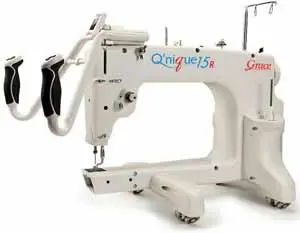
If you’re serious about quilting, you need to have an appropriate machine in your disposal.
By appropriate I mean the machine that can facilitate larger projects. The machines should have great stitching speed, extended throat space and advanced settings to perform various operations.
With Grace Q'nique, each of these traits is covered. This is a long arm quilting machine, so you know you’ll be able to handle large projects on this one. The machine has a space of around 15 inches, hence known as the 14+ model.
The Q'nique is one of the fastest sewing machines out there. It delivers a whopping 1800 stitches per minute. While that’s great for free motion, you might want to hold the horses for regular stitching. Grace made that easy to with simple buttons on the comfort handle, which is covered with a comfy grip.
You can adjust the speed through the buttons. They provide another facility when you choose stitches per inch, they determine the appropriate stitch length for consistent and even stitching.
The machine contains 4 stitch modes, each perfect for specific jobs.
In the Precise mode, you determine the stitch per inch. The regulator will automatically adjust the sewing speed as you go faster or slower.
In the Cruise mode, you determine the SPI, but you also determine a minimum stitching speed. So when you get slower, the regulator will maintain that minimum stitch speed.
Baste mode allows you to do long, medium or short basting stitches at the end of your quilting edges.
Manual mode allows you to control the stitch speed by yourself. The handlebar contains a button that’ll help you with that. It’s great for complex stitching operations.
The large LCD display is a treat for the eyes. It lets you set the stitching mode, length, and speed easily. You can also adjust the needle position from here. Also, you can determine the default needle position (up/down) with the push of a simple button.
Highlighted Features:
15. Janome MC-6300P Professional Heavy-Duty Computerized Quilting Machine
It’s very difficult to please hardcore seamstresses, they just can’t get enough of it.
You cannot blame them. They have an inclination for quality. And since they have to work on serious projects, they can be anything but lenient.
The Janome MC-6300P can quench the thirst of a serious user. At least up to a level. It comes with 66 stitching options and 4 buttonholes. Not much compared to other products we reviewed, but decent for the price.
It has a throat space of 9″ x 5″, which is enough for most users. It can operate at a maximum speed of 1000 SPM. You can adjust the speed as you see fit. The maximum stitch width and length you’ll get from this machine is 7 mm and 5 mm. Then again, you can adjust the span by pressing + and – side of respective buttons.
The machine comes with some automatic features. The automatic thread tension doesn’t let the thread get loose. The automatic bobbin winder lets the user install the bobbin and get started as quickly as possible. Finally, the automatic thread cutter with memory feature will remember when and where to cut the thread automatically.
The memory function is something that’ll make your job easier. It can recall your pressure needle position, whether it is up or down. It can also remember your last stitch so that you can take from where you left last time.
Hardcore quilters will love the fact that this machine comes with a knee lift lever. Now you can lift the needle up and down without needing to engage your hands. You can adjust the pressure from 0 to 3 using the foot lift. The drop feed lever allows you to lower the feed dog for free motion sewing.
Highlighted Features:
16. George Sit-Down Quilting Machine From APQS
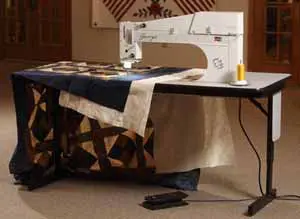
Quality things don’t always come in fancy appearances.
Take George Sit-Down Quilting Machine. It might not look astonishing like a modern computerized machine, mainly because it doesn’t have one. But the moment you set your eyes on this machine, the large working area will soothe you. This is a long arm sit down quilting machine.
It comes with a 20 inches working space, clearly beating its counterparts. You can sew large blankets and bed covers with this one, and won’t feel any stress regulating the fabrics. It can deliver a huge SPM of 2400 at maximum speed.
This one is a heavy machine at 35 pounds. But that’s the reason you won’t experience irritating hums as you sew through the fabrics. You might think it will be a hassle to maintain such a machine, but that’s not the case. In fact, while other machines require daily oiling through 7-8 ports, this one needs way lesser lubrication to function.
The operating method is surprisingly easy. The threading can be done quickly and effortlessly with one tension dial. The dial maintains the upper tension. Interchangeable hopping foot lets you change the foot quickly to customize your sewing operation.
The machine runs with DC motor and synchronous belt drive system. The system ensures your stitch tension and integrity will remain the same and won’t fall. The auto needle positioner makes sure the machine stops at either full up or full down position.
Overall, this is a pricey machine, but the build and features justify it. You’ll love to quilt in this beast, and the customer support system they have in place is fabulous.
Highlighted Features:
Things To Before Consider Buying Best Sewing Machine For Quilting And Embroidery
Stitch Function
Stitch functions decide how far you can go with your quilting machine. These options allow you to make complex and fancy designs. Good quality machines usually have options to more than one hundred of stitch functions.
However, the number isn’t everything. There are other factors like stitch length and width. If you are just starting, you can go with a lower number of stitches, and work your way up as you gain experience.
Also if you’re going to work on long stitches, make sure the machine has stitch length and width adjusting capability. Some machines offer font function, which allows you to put your own marks on the fabric.
Machine Power
Since you’re going to stitch several layers together, it’s important that your machine is powerful enough to accomplish that. The layers can be thick at times, and the machine should be able to go through multiple layers of clothes with ease.
The products we reviewed has a varying degree of power. You can judge the power by the motor rating provided by the manufacturers. If you have to stitch denser fabrics on a regular basis, make sure to choose higher motor ratings.
Working Space
Quilting isn’t like regular stitching. It involves joining fabric layers one over another. It's only normal that the user will need ample space to regulate the fabrics. Otherwise, the process will be tiresome as he/she would have to roll fabrics frequently.
So how to solve that? By getting a machine with larger throat space. Larger space means you can quilt more areas with any break. If you need more space, getting a machine that comes with more space will come handy. You can attach the table with the machine and maneuver the fabric more easily.
Feet Types
Check if the machine comes with more feet options, other than the one provided by manufacturers.
Walking Foot- This will feed your fabric from the top, while the feed dogs feed the fabric from the bottom. As a result, your quilts will be even and parallel. And you’ll face no puckering between two layers.
Quarter Inch Foot- If your sewing project involves patchwork, this foot will come handy. They come with an edge or guide which you can keep in line with your fabric edge, making sure you have a constant ¼ inches seam allowance.
Free Motion Foot- Also known as the darning foot or meandering foot. If you are aiming for free motion quilting, then you’ll need a free motion pressing foot.
Quilting Guide- If you intend to do a lot of free motion work, you can acquire a gadget named free motion guide grip. This gadget will allow you to have more control over the fabric movement, and evenly sew the parallel lines for the layers altogether.
Needle Up/Down
When you stop sewing, where does the needle stop? Does it stop fully upwards or fully downwards? Top-notch quality machines will stop all the way down.
Why? Because when you rotate your quilt top or move the corners, the initial position where you stopped the stitching might shift underneath the needle. If you’re careless, you might end up stitching in the wrong position.
Sewing machine with quilting features should come with the needle down by default. This position helps improve accuracy, saves time and disappointment. Some machine comes with default up position but allows you to set the needle down position, so they’re equally as good.
Presser Foot Pressure
Since you’ll be several layers of fabrics, one over another, it’s only normal that they might move. You’ll have drag and puckering problem. To avoid this, it’s important to apply pressure to the quilt while stitching in a straight line. Pressure foot helps with that.
Quilts need less pressure than patchworks, as the fabrics are thicker. Likewise, a thicker quilt needs less pressure than thinner quilts. However, any sewing machine that allows you to adjust the pressure of the pressure foot will add a convenience.
Nature Of Your Work
Are you a professional quilter? Or you’re one who’s just looking for a way to express his/her artistic vision? Before buying a sewing machine for quilts, the user must determine what the intention for buying is.
I mean, do you quilt occasionally? Do you have a time frame you must finish your work within? If not, you can go for small to medium arm machines. Although they take a long time to stitch, they’re affordable, portable and can be controlled easily.
On the other hand, if you’re looking to set up a serious business, have to work on a schedule, then long arm machines will serve you better. You can even make several quality quilts a day. They usually come with a higher price tag, but they are worth the money.
Also, the type of fabrics you usually sew will determine your ideal choice. For thick quilts, longarm machines are better. For normal home uses, medium arm, or even small arm will suffice.
Vibration
Some users may face irritating vibrations while doing sewing works. As a sewing machine converts circular motion to a two-directional motion, it’s not unnatural to experience wobbling and vibration.
However, the weight of the machine can help to dampen the vibration. Sewing machines with a heavy metal frame are durable, less prone to damage and above all, help dampen the vibration while sewing.
Additional Features
Automatic Thread Cutter- Some machines come with automatic options to cut the thread, just by pressing a button on the machine or foot pedal. It can save a lot of time and thread when stopping and starting quilting at the edge of the fabric.
Knee Lift- This is a lever which is activated by the knee. Although it might look funny, it actually saves time during the quilting process. It helps to lift or lower your pressure foot, freeing your both hands to hold and position the fabric.
Speed Control- It allows you to stay comfortable during free motion quilting. If you’re just starting out, this feature will help you avoid mistakes and be in control.
Stitching Rate- Some machines come with higher SPM than the others. Although this isn’t a good factor while stitching curved lines, for straight lines it can help speed up the process. Quilting sewing machines for beginners don’t necessarily need to have high SPM. But once you’ve learned the trade, it will allow you to stitch or border the quilts quickly.
Different Types Of Machines For Quilting
You won’t find many differences between a quilting machine and a modern sewing machine when it comes to appearance. However, quilting machines nowadays do more than just quilting. In fact, they go out of their way and try to provide usual sewing options as well as embroidery options.
You’ll find machines you can use a thread spool with, machines that come with built-in stitches and automatic features. You’ll be able to do every chore without needing another machine.
More advanced quilting machines come with embroidery options. You can download or install patterns according to your liking. Some machines even allow you to customize every stitch within a pattern.
These are the options you can choose from when buying a sewing machine with quilting features. As for classification based on physical attributes, quilting machine can be categorized into three types. Long-arm, Mid-arm, and Short-arm.
The arm is the top, slim, horizontal part of a sewing machine. The arm length is determined by the distance between the needle on the left and the vertical part on the right. The arm length is important because it determines how freely you can move your fabrics during stitching.
The space underneath the arm is also important. The arm length and the space between the arm and the base decide whether the user will get ample space to regulate fabrics. This space is often known as the throat space or the harp.
Now, it’s clear from the names, the classification of the quilting machine is done by the length of the arm. The long-arm has the longest frame and it gradually decreases for the other types.
Long-arm: Throat space of 18 inches or more.
Mid-arm: Throat space of 12-17 inches.
Short-arm: Throat space below 12 inches.
Remember, the lengths specified for each type isn’t something universal. Sometimes you might see a 14 inches machine is called a long-arm.
However, how we call them isn’t important. What’s important is you need a big enough machine that can facilitate large fabrics. Depending on your needs, you can purchase one from the categories. Larger throat space means, you will be able to quit without break for a long time before rolling it up for another round of quilting.
How To Use?
So, you’ve purchased your quilting machine and eager to start with the process. How do you use it? How to set it up? Check out the steps of using a quilting machine.
1. Oiling- First of all, read the manual carefully. It will contain all the information you need. Before you go and start using the machine, it’s good to oil the parts so that they can function smoothly.
Usually, sewing machines come with small holes through which the oil reach all parts. Check the manual for such holes and pour oil drops there. Make sure you keep the use confined instead of flooding the machine.
2. Set Stitching Speed- The fabrics used for quilting are usually thick. They become even denser when put together one above another. That’s why it’s possible to lose control while stitching at high speeds.
Even if you’re a professional, set the speed to low first. Work your way up gradually. While you can stitch fairly fast for straight stitches, careful when it comes to curve stitches.
3. Attach Quilting Table- Do this step whenever needed. Some machines come with detachable tables so that you don’t have to carry them all the time. Whenever you’re working with fabrics too big, make sure you’re using the table. Otherwise, the fabrics won’t rotate and the process will become tiresome.
4. Select Foot- For quilting, you’ll need a specialty foot, depending on your work. For free motion stitching, you need a darning foot. For patchwork, you need quarter inch foot. For more control over the fabric, you can use the quilting guide.
Make sure you attach the foot before you get started with the sewing process.
5. Needle Position- Needle position is important to maintain accuracy. Machines with default downward needle are better. Because when you stop sewing, the needle stays inside the quilt. This way, there is no chance for the fabric to wander below the needle.
All you have to do is raise the pressure foot. Then you can change the direction of stitches.
6. Ditch Quilting- Also known as 'stitch in the ditch', this is one of the most common and popular quilting methods. This refers to quilting the fabric along the lines of the patchwork.
It doesn’t add much texture, but it adds another design. The concept is the stitching will be entrenched on the seam line, and won’t be visible much. You start sewing from the lower side of a seam, or as close as possible. Then you continue maneuvering and navigating the sandwich.
Top Quilting Sewing Machine Brands On The Market
Kailin Gow once said, “Mechanical things can be fixed...People matter more." That’s even truer for equipment like sewing machines. I mean, they’re bound to show trouble from time to time. But does the company show enough heart to hear to its customer? Does it provide adequate after sales service?
Well, if you purchase a sewing machine from a company that has been around for years, with reputation, then you can rest assured. We’re going to discuss such brands that have revolutionized the world of quilting machines. Thus, they don’t disappoint their customers.
Singer
Probably no Company has been so popular for their sewing machines like Singer. Their reputation proceeds so far, that Singer and sewing machine are kind of synonymous.
Started from 1851, this company has been a pioneer for many inventions like the zigzag machine, the electronic sewing machine, the sewing machine mobile app. They manufacture all sorts of sewing machines including general, embroidery and quilting. They have reached to Global population in a manner very few companies have been able to.
Brother USA
This company was established in 1954, so it comes with a rich history. They provide various home and business products including sewing machines, printers, gear motors etc.
They have a million-square-foot distribution center, resided in Tennessee, and a worldwide distribution network. What makes them unique is they try to anticipate the needs of their customers to come up with innovative, superior products.
Janome
Being one of the pioneers who manufactured long arm quilting machine for home uses, Janome is a trusted name among sewing enthusiasts. Not only that, they continuously worked on their sewing machine ever since, introducing new technologies.
The fourth generation long arm machine is an example of that. They also came up with technology defining wireless enable sewing machines, mobile apps, and many more new features. Not only they focus on performance, but they look out for the user comfort as well.
Juki
With more than 80 years of experience at its disposal, Juki has surpassed the borders of Japan reached worldwide. It manufactured its first household sewing machines in 1947, and that’s the year they entered the market of the USA.
Juki monitors its production with famous Japanese quality control philosophies. As a result, it was able to acquire a major sewing machine manufacturing company in America name Union Special. Nowadays, they have sales company all around the world.
Eversewn
Eversewn is an innovation-focused company that has contributed to the sewing industry with many of its equipment. For example, they manufacture sewing machines, starter kit and other equipment associated with sewing.
Eversewn is especially focused on empowering kids, and try to build their interest in sewing and crafting. Their products can be used by any level of users, and kids especially feel connected with them thanks to their eye-pleasing products.
Grace
Like the name, this company brings elegance and comfort in sewing. They have been especially focused on quilting machines. Apart from the machines, the also manufacture quilting frame, stitch regulators, quilting pattern software.
Some of their popular software are Quilt Motion, Quilter’s Creative Design, and Quilter's Creative Touch. They combine traditional quilting methods with modern technology. The result? Praise from thousands of satisfied customers.
How To Clean Quilt Machine?
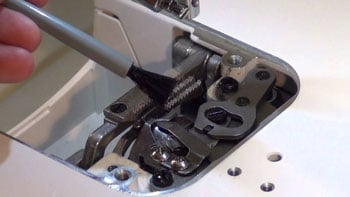
What’s the best way to get the value for the money? Yes, you guessed it right, using it for a long time, until every penny you spent is paid off. To achieve that, you need your machine in a tiptop condition.
When was the last time you opened your sewing machine and cleaned those dust bunnies? How long ago did you oil the machine? A functional problem can be very irritating, especially when you’re working on a project. To avoid these problems, clean your machine regularly. Here are some tips that might help you.
1. Go Through The Manual
That’s because the best place to take advice about a machine is the manufacturers, not some “know it all” person. Make sure you read about the Do’s and Don’ts. If the machine doesn’t come with a manual, which is very unlikely, look up on the internet or contact the local dealer for more information. Make sure you seek information for the specific brand and serial number you use.
2. Get The Tools
No, you don’t need a warehouse of tools to get the job done, just some simple tools will suffice. You’ll need-
3. Disintegrate Parts
Start by shutting down the machine. Remove the spool thread carefully. Remove the pressure foot and the needles. It’ll be ideal if you dispose of the needle carefully and start using a new one.
Remove the stitch plate. Usually, that can be done by popping a button, but you might need to remove screws too. Finally, remove the bobbin case and the bobbin.
4. Start Cleaning
After disintegrating the parts, start with giving your machine a good wipe. You should use a soft cloth like muslin. Using a mild cleaner to slightly dampen the cloth can improve the cleaning quality.
Clean the bobbin case with a soft brush. After that, try to clean all the dust and lint under the stitch plate and bobbin case. You can use a mini air vacuum or canned air for this process. Make sure you remove them away instead of steering them inside the machine, hold the vacuum in an angle so that you can avoid this scenario.
Use the stiff bristle brush to clean the rest of the dust bunnies. If the spot doesn’t look completely clean even after that, don’t stress yourself. Be happy with the progress and leave it for your dealer.
Lint off the feed teeth using the stiff brush. The old needle you’re going to dispose of will come handy to clean the feed channel.
Finally, clean the tension disks if needed. Disintegrate them by using the pressure foot. Use a dental floss back and forth to clean the channel.
5. Reassemble The Machine
While putting the parts back, look up to the manual. For caution, you can take a snap before disintegrating the part so that you can remember how they were.
Put the bobbin case back in, use the hand knob to place it rightly. Slide the needle plate and tighten it by the screws. Put the pressure foot back. Set up the new needle. A needle has a round side and a flat side. Check the instruction manual to know which way the needle should face.
Push the needle clamp as far as you can. Tighten the thumb screw, ideally using a screwdriver.
After putting all the parts back, give the machine exterior a final wiping. Wipe off any dust or lint that might have been left. That’s it! You got your quilting machine up and running like a new one.
Tips To Take Care And Maintain Your Machine
We all wish of a machine that’ll serve us for years and it won’t even need any maintenance. Well, that’s possible in fairyland, but we don’t live in one. However, maintaining your Best Sewing Machine For Quilting isn’t much of a hassle. You just need to keep a few simple things on your mind.
1. Use Cover- Bare eyes might not be able to catch it, but the air carries dust particles with it. Modern sewing machines are made of delicate parts, and that’s even truer for computerized sewing machines. Cover your machine when you’re not using it to keep the dust away as much as possible.
2. Regular Cleaning- Even an efficient machine can lose its competence over time if not cleaned and maintained regularly. Dust is always going into your machine. As if that wasn’t enough, every time your needle piercing the fiber, there are microfibers that are possibly going inside the machine.
The solution is disintegrating the parts and clean them from time to time. We have discussed the cleaning process above, so don’t mind to take a look.
3. Use Appropriate Accessories- Your machine will quickly approach its annihilation if you don’t use good quality and appropriate accessories with it. For instance, use good quality threads and needles that are recommended by the manufacturer.
4. Apply Oil Regularly- Well, this one is important. The friction of parts is inseparable when it comes to machines. The best way to keep them working properly is to reduce friction as much as possible.
Some machines come with oiling channel and you only need to pour oil drops in a hole, the channel will do the rest. However, for older machines, you might need to disintegrate the parts and oil them separately. Wipe off any access oil after the application and keep the machine running without any fabrics for 3 minutes.
5. Change The Needle- It’s normal to think that the old needle will get the job done since it’s still sharp. But remember, your skin and fabrics aren’t the same. Needles lose their piercing capability after a period of use.
What happens next is the machine has to take up extra pressure to get the job done. This reduces machine life. Change the needle regularly so that it can pierce through the fabrics easily without putting additional pressure on the machine.
6. Tighten The Screws- A sewing machine is nothing but delicate components put together by screws and other attachments. And it’s only natural for screws to come loose on the course of long use. As a result, wobbling of the machine and noise problem can emerge.
While the parts might look like they are attached securely. Do a close inspection every few months. Make sure the screws are tight, and if needed, tighten them. This job will be done anyway when you clean your machine by disintegrating the parts.
7. Remove The Lint- While you are sewing, microfibers are being produced as well. The needle pushes them into the machine. Eventually, they gather together and clog the machine.
Use a brush to clean them on a regular basis. Also, cut the threads if you find them clogged to avoid jamming the machine.
8. Regular Servicing- Getting in the touch of a professional who knows his things can’t usually go wrong! I mean, if you’re feeling the performance is tanking, maybe it’s time to replace some parts or give the machine a good servicing.
Also, friction is something that can be reduced, but not entirely eliminated when it comes to a machine. Friction reduces working performance.
Either way, go to a professional who knows about sewing machines and makes sure to address the issues.
Different Uses Of Your Quilting Sew Machine
Quilting machine isn’t a one trick pony. In fact, you can accomplish pretty much any sewing job with this machine. Here are some of the uses-
1. Blanket- Blankets are handy when the environment is cold and you need a warm touch. But that’s doesn’t mean it can’t be a piece of art. The most useful application of sewing machines for quilting is sewing blankets. Since a blanket needs to provide warmth, thus it is thick in nature. Quilting machine comes useful to sew three or more layers of fabrics.
2. Wall Mat/ Floor Mat- Wall mats are made for purely decoration purpose, while floor mats actually help to keep your floor clean. However, a decorative, beautifully sewn floor mat will lift up the mood of any guest. Also, a creatively designed wall mat will help increase the elegance of your room.
3. Repairing Cloths- A quilting machine can be used for general purpose, of course. If you own one, you’ll be getting all the basic functions, plus many more. You can repair torn clothes or make adjustments to any outgrown garments. You can choose from numerous stitching options so that the repair looks like a fashion statement instead.
4. Embroidery Options- Although there are specialized sewing machines for embroidery, you can easily do basic embroidery stitching by your quilting machine. Most of these machines can embroider automatically, you just need to plug in a template and it will do the rest. However, the embroidery designs come in the form of snugly-spaced quilting stitches. If you want specialized embroidery, like the ones in hats and towels, buying an embroidery machine will be a wiser choice.
5. Building A Business- This is exactly not a use per se, rather an advantage to be specific. You see, many people who are interested in sewing don’t own a quilting machine. And they need some quilting work done every now and then. You can earn some extra bucks from helping them out. Also, you can accelerate the fabrication of different quilting based products and sell them at a decent price. After all, they’re hot products on the market.
Common Quilting Machine Troubleshooting
Machines come with problems, that’s the accepted truth. But you’ll be damned if you have to run to the dealer every time a problem pops up. With a little bit of courage and help from us, you can solve the common problems. These solutions will help you get back your machine up and running in no time.
1. I Am Getting Skipped Stitches On My Machine, What To Do?
Before approaching this problem, you need to find answers for a few things.
If you’re in a regulated mode and confronting the skipping of stitches, then your encoder is damaged or missing. If the vertical stitches are missing, then the Y-axis encoder is damaged. For horizontal misses, it’s the X-axis encoder. If that happens, it’s time to replace your encoder.
If you’re missing stitches on both directions, it may be due to the needle. Probably you have installed a needle recently and didn’t place it properly. See if the needle is all way back to the needle bar. This problem can also happen if you switch to a thinner needle.
If the needle is penetrating but not stitching, the probable cause is your needle bar has been moved. Check the height and make adjustments if that’s the case.
If your needle is hesitating and not running smoothly, and all of the abovementioned things are okay, then your motor belt is probably slipping. Raise the motor to the proper position to increase the tension. You might have to replace it if it is damaged beyond repair.
2. The Tension Isn’t Balanced, Causing Loops Or Dots Of Thread
Before you start your project, work on a piece of scrap fabric to determine the machine is running properly. If the stitches are done correctly, then the tension is okay. If you see loops or dots, you need to work on speed. The speed of your stitching, and the speed you move your quilts under the needle.
Also, you need to adjust your tension, based on the location where the loops are happening. Adjust the top tension only. If the top stitches are tight, adjust by lowering the top thread tension number. This will loosen it. Increase the number if the top stitches are loose.
3. Running Out Of Bobbin Or The Thread Broke At The Middle
If one of either scenario happens, don’t worry. Just pull out enough stitches and tie a knot. Then pop it into the batting. Leave the loose ends and start quilting from the spot where you left.
But the better course of action is avoiding the scenario altogether. Stitch the end of the quilt whenever possible and check the bobbin level. If it’s running low, replace it with a new one. Use the remaining bobbins for smaller or trial projects.
4. The Needle Has Broken, What To Do?
This happens when the needle cannot move on its due course. Probably the needle was off center while you were using a straight stitch throat plate, or the thread pulled it off-position and it hit the plate.
Either way, you need to insert a new needle. Make sure the needle isn’t too thin. Use the needle manufacturers recommend.
It’s common for beginners to pull the fabric under the needle. It increases pressure on the needle and bends it. Refrain from doing it.
Make sure the needle is centered if you’re using a straight stitch throat plate. Make sure the throat plate and the foot are installed correctly and tightly.
5. The Fabric Doesn’t Feed Properly
Well, that can be frustrating. However, check a few things if that happens.
The feed dogs are positioned to the ‘up’ direction.
Are you using pressure foot pressure? Perhaps you were machine quilting and forgot to attach it.
Is the pressure foot installed properly?
Is the pressure foot making contact with the fabric?
What is your stitch length? Is it higher than zero?
If your solution relies on any of these questions, address it and make necessary adjustments. However, if all of these facts are okay and you’re still facing the problem, then your timing is probably off. It’s time to go to your dealer.
Frequently Asked Questions (FAQs) About Sewing Machine
1. Can My Normal Sewing Machine Do The Quilting?
Yes, you can. You can achieve many textures with simple straight stitching. A walking foot gives even better performance.
However, these machines have a limitation when it comes to quilting. Often, they don’t have enough space for the fabrics to regulate. The stitching might not be good enough to hold several layers. It’s better to buy a specialized machine if you’re serious about quilting. You can do regular sewing with that too.
2. What Is The Appropriate Stitch Length For Machine Quilting?
If you’re using a walking foot and doing straight stitches, the most appropriate length will be 2.5 to 3. That is about 8-12 stitches per inch depending on the expertise of the user. This range works for most of the machines.
If the threads are sparkling or shining, make longer stitches, so that they can be seen well. On the other hand, use shorter stitches for monofilament threads.
If you use a thicker thread, like 30 weight rayon, go for longer stitches. Otherwise, the stitches will look forcefully inserted into the quilt.
3. What Kind Of Needle Is Needed For Machine Quilting?
Since quilting usually involves working with thick garments, the needle should be capable of withstanding the burden. Always use manufacturer recommended needles and refrain from using thinner needles.
The most common size for machine quilting needles is 90/14. It has a nice big eye to accommodate thick threads. And it is sturdy enough to work with several layers of fabric.
4. What Speed Is Required For Machine Quilting?
Depends on the requirement and expertise of the user. However, it’s always better to start slow. This way you can make sure the fabric won’t rip.
If you’re using a free motion foot, the speed doesn’t affect the stitches much. However, it affects your control over the operation. Always try to keep the machine speed and the speed of your hand uniform, so that the stitches are even.
If you’re unable to control the stitching speed on a regular basis, try using a stitch regulator.
5. What The Tension Settings Should Be For Machine Quilting?
It’s better to leave it alone and not play with it. If you’re using the same thread for bobbin and needle, you don’t have to change anything. However, for different threads, you might have to make some adjustments. Determine if the tension is too tight or too loose and adjust according to it.
6. Can I Use Polyester Thread For Quilting?
It’s a never-ending debate. Which one is better for quilting, polyester or cotton threads? Sometimes it matters, sometimes it doesn’t matter, especially when you use high-quality threads.
The argument for polyester is, it produces less lint in your machine. However, they are vulnerable to heat. There is a notion that polyester threads will tear down the cotton quilting fabric they’re used on. But that hasn’t been proved true.
On the other hand, cotton produces a lot of lint. But they can be a good choice for products that come in touch of heat often, like mug cozies, potato bag, hot pads.
So the answer is, yes! Depending on your use, you can definitely use polyester threads. And in times, it will probably prove beneficial because these threads are strong and durable.
Final Words
We’re at the end of our detailed guide on quilting machines. You can always do quilting on a regular machine. However, having the best quilting sewing machine will give you more freedom and options. On the plus side, you can easily work on general sewing projects other than quilting.
It’s easy to be fooled with fancy features like stitching options when you buy these sewing machines. But it’s important to keep your mind in check and make decisions based on more important factors like throat space, machine power, and default needle position.
This quilter machine review guide will help you separate milk from water. The products we reviewed has good consistency and reliability history. We were also careful enough to list products for people with different needs. Hopefully, you’ll find your Best Sewing Machine For Quilting from this list. Adios!
Thanks for reading.

